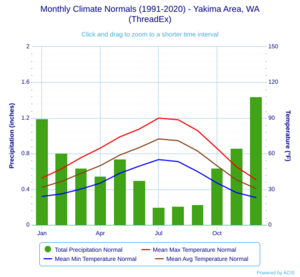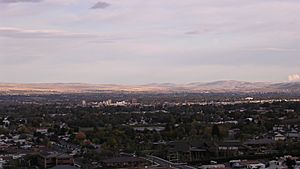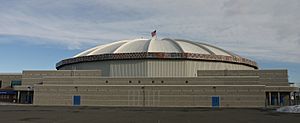Yakima, Washington facts for kids
Quick facts for kids
Yakima, Washington
|
||
|---|---|---|
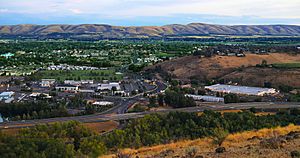
Yakima as viewed from Lookout Point
|
||
|
||
| Nickname(s):
The Palm Springs of Washington; The Heart of Central Washington
|
||

Location of Yakima in Yakima County
|
||
| Country | United States | |
| State | Washington | |
| County | Yakima | |
| Incorporated | December 10, 1883 | |
| Government | ||
| • Type | Council–manager | |
| • Body | City council | |
| Area | ||
| • City | 28.32 sq mi (73.35 km2) | |
| • Land | 27.86 sq mi (72.16 km2) | |
| • Water | 0.46 sq mi (1.19 km2) 1.84% | |
| Elevation | 1,070 ft (326 m) | |
| Population
(2020)
|
||
| • City | 96,968 | |
| • Estimate
(2023)
|
96,750 | |
| • Rank | US: 350th WA: 11th |
|
| • Density | 3,473.0/sq mi (1,341.0/km2) | |
| • Urban | 133,145 (US: 257th) | |
| • Metro | 256,643 (US: 193rd) | |
| Demonym(s) | Yakimanian | |
| Time zone | UTC–8 (Pacific (PST)) | |
| • Summer (DST) | UTC–7 (PDT) | |
| ZIP Codes |
98901–98904, 98907–98909
|
|
| Area code(s) | 509 | |
| FIPS code | 53-80010 | |
| GNIS feature ID | 1509643 | |
Yakima is a city in Washington, United States. It is the main city of Yakima County. Yakima is the 11th largest city in Washington state. In 2020, about 96,968 people lived there. The larger area, including nearby towns, has about 256,728 people.
Yakima is about 60 miles (97 km) southeast of Mount Rainier. It is in the Yakima Valley. This area is known for growing many crops. These include apples, grapes for wine, and hops. Hops are used to make beer. In fact, in 2011, the Yakima Valley grew 77% of all hops in the United States. The city's name comes from the Yakama Nation Native American tribe. Their reservation is located south of the city.
Contents
History of Yakima
The Yakama people were the first known people to live in the Yakima Valley. In 1805, the Lewis and Clark Expedition explored the area. They found lots of wildlife and rich soil. This encouraged settlers to move there. A Catholic mission was built southwest of where Yakima is now in 1847.
Early Conflicts and Settlement
When more settlers arrived, there were conflicts with the Native Americans. This led to the Yakima War. The U.S. Army built Fort Simcoe in 1856. This was to respond to the fighting. The Yakamas were defeated and had to move to the Yakama Indian Reservation.
Yakima County was created in 1865. In 1884, the Northern Pacific Railroad decided to build its tracks away from the original town site. So, over 100 buildings were moved using rollers and horses to the new train depot area. This new city was called North Yakima. It became an official city and the county seat on January 27, 1886. The name was changed to Yakima in 1918. The old town site became known as Union Gap.
Mount St. Helens Eruption
On May 18, 1980, Mount St. Helens erupted. A lot of volcanic ash fell on Yakima. It was so thick that people could barely see. The ash also caused problems for the city's water treatment plant.
Geography of Yakima
Yakima covers about 28.32 square miles (73.35 km²). Most of this is land, with a small part being water. The city is 1,095 feet (334 meters) above sea level.
Yakima Valley Location
Yakima is in the Upper Valley of Yakima County. The county is split into two parts by Ahtanum Ridge and Rattlesnake Ridge. These are the Upper (northern) and Lower (southern) valleys. Yakima is in the more developed Upper Valley. It is the main city of the Yakima Metropolitan Area.
Nearby areas include West Valley and Terrace Heights. Other towns close by are Moxee, Tieton, and Naches in the Upper Valley. In the Lower Valley, you'll find towns like Wapato, Sunnyside, and Grandview.
Waterways and Parks
The Yakima River flows through the city. It starts at Lake Keechelus in the Cascade Range. It then flows into the Columbia River at Richland. The Yakima River is very important for watering farms in the Yakima Valley. People also use it for fishing and fun activities. The Naches River is another river that forms the northern edge of the city.
The Yakima Greenway is a 20-mile (32 km) system of parks and paved paths. It runs along the Yakima and Naches rivers. This project started in 1983. They turned an old city landfill into Sarg Hubbard Park, which opened in 1990.
There are also several small lakes on the northern side of the city. These include Myron Lake, Lake Aspen, and Rotary Lake. They are popular for fishing and swimming in the summer.
Climate in Yakima
Yakima has a cold semi-arid climate. This means it's quite dry, especially in summer. Winters are cold, with December being the coldest month. The average snowfall is about 21.6 inches (55 cm) per year. Most of this snow falls in December and January.
Spring warms up slowly. Summer days are hot, but the temperature drops a lot at night. There are about 40 days a year when the temperature reaches 90°F (32°C) or higher. Sometimes it can even reach 100°F (38°C). Autumn cools down quickly. Because Yakima is in a "rain shadow," it doesn't get much rain. The average rainfall is only about 8.01 inches (20.3 cm) per year.
| Climate data for Yakima Airport, Washington (1991–2020 normals, extremes 1946–present) | |||||||||||||
|---|---|---|---|---|---|---|---|---|---|---|---|---|---|
| Month | Jan | Feb | Mar | Apr | May | Jun | Jul | Aug | Sep | Oct | Nov | Dec | Year |
| Record high °F (°C) | 68 (20) |
70 (21) |
80 (27) |
92 (33) |
102 (39) |
113 (45) |
109 (43) |
110 (43) |
100 (38) |
91 (33) |
73 (23) |
72 (22) |
113 (45) |
| Mean maximum °F (°C) | 56.3 (13.5) |
59.1 (15.1) |
70.0 (21.1) |
79.7 (26.5) |
89.9 (32.2) |
95.8 (35.4) |
101.5 (38.6) |
100.3 (37.9) |
92.1 (33.4) |
78.3 (25.7) |
64.9 (18.3) |
54.4 (12.4) |
102.9 (39.4) |
| Mean daily maximum °F (°C) | 39.5 (4.2) |
47.2 (8.4) |
56.6 (13.7) |
64.7 (18.2) |
74.1 (23.4) |
80.7 (27.1) |
89.9 (32.2) |
88.5 (31.4) |
79.4 (26.3) |
64.4 (18.0) |
48.9 (9.4) |
38.2 (3.4) |
64.3 (17.9) |
| Daily mean °F (°C) | 31.7 (−0.2) |
36.6 (2.6) |
43.4 (6.3) |
49.9 (9.9) |
58.8 (14.9) |
65.1 (18.4) |
72.4 (22.4) |
70.9 (21.6) |
62.2 (16.8) |
49.8 (9.9) |
38.0 (3.3) |
30.6 (−0.8) |
50.8 (10.4) |
| Mean daily minimum °F (°C) | 24.0 (−4.4) |
26.1 (−3.3) |
30.2 (−1.0) |
35.2 (1.8) |
43.5 (6.4) |
49.5 (9.7) |
55.0 (12.8) |
53.3 (11.8) |
44.9 (7.2) |
35.3 (1.8) |
27.2 (−2.7) |
23.1 (−4.9) |
37.3 (2.9) |
| Mean minimum °F (°C) | 7.4 (−13.7) |
11.4 (−11.4) |
19.7 (−6.8) |
23.9 (−4.5) |
30.2 (−1.0) |
36.8 (2.7) |
43.8 (6.6) |
42.3 (5.7) |
33.8 (1.0) |
21.3 (−5.9) |
13.2 (−10.4) |
8.1 (−13.3) |
0.5 (−17.5) |
| Record low °F (°C) | −21 (−29) |
−25 (−32) |
−1 (−18) |
18 (−8) |
25 (−4) |
30 (−1) |
34 (1) |
35 (2) |
24 (−4) |
4 (−16) |
−13 (−25) |
−17 (−27) |
−25 (−32) |
| Average precipitation inches (mm) | 1.19 (30) |
0.81 (21) |
0.64 (16) |
0.55 (14) |
0.74 (19) |
0.50 (13) |
0.20 (5.1) |
0.21 (5.3) |
0.23 (5.8) |
0.64 (16) |
0.86 (22) |
1.44 (37) |
8.01 (203) |
| Average snowfall inches (cm) | 6.2 (16) |
2.7 (6.9) |
0.6 (1.5) |
0.0 (0.0) |
0.0 (0.0) |
0.0 (0.0) |
0.0 (0.0) |
0.0 (0.0) |
0.0 (0.0) |
0.1 (0.25) |
3.0 (7.6) |
7.7 (20) |
20.3 (52) |
| Average precipitation days (≥ 0.01 in) | 9.5 | 7.3 | 6.6 | 5.6 | 6.3 | 4.6 | 2.2 | 2.2 | 3.0 | 5.9 | 8.3 | 10.3 | 71.8 |
| Average snowy days (≥ 0.1 in) | 4.4 | 2.0 | 0.7 | 0.1 | 0.0 | 0.0 | 0.0 | 0.0 | 0.0 | 0.1 | 1.5 | 5.5 | 14.3 |
| Average relative humidity (%) | 77.7 | 72.7 | 60.6 | 51.6 | 48.2 | 46.8 | 44.3 | 48.2 | 55.6 | 63.4 | 74.5 | 79.8 | 60.3 |
| Average dew point °F (°C) | 22.8 (−5.1) |
27.3 (−2.6) |
28.8 (−1.8) |
30.9 (−0.6) |
36.7 (2.6) |
42.6 (5.9) |
46.0 (7.8) |
46.9 (8.3) |
42.3 (5.7) |
35.1 (1.7) |
30.0 (−1.1) |
23.9 (−4.5) |
34.4 (1.4) |
| Mean monthly sunshine hours | 64 | 113 | 186 | 210 | 279 | 300 | 341 | 310 | 240 | 186 | 60 | 62 | 2,351 |
| Mean daily sunshine hours | 2 | 4 | 6 | 7 | 9 | 10 | 11 | 10 | 8 | 6 | 2 | 2 | 6 |
| Percent possible sunshine | 22 | 38 | 50 | 51 | 60 | 63 | 71 | 71 | 64 | 55 | 21 | 23 | 49 |
| Average ultraviolet index | 1 | 2 | 3 | 5 | 6 | 7 | 8 | 7 | 5 | 3 | 1 | 1 | 4 |
| Source 1: NOAA (relative humidity, and dew point 1961–1990) | |||||||||||||
| Source 2: Weather Atlas (sun and uv) | |||||||||||||
People of Yakima
| Historical population | |||
|---|---|---|---|
| Census | Pop. | %± | |
| 1890 | 1,535 | — | |
| 1900 | 3,154 | 105.5% | |
| 1910 | 14,082 | 346.5% | |
| 1920 | 18,539 | 31.7% | |
| 1930 | 22,101 | 19.2% | |
| 1940 | 27,221 | 23.2% | |
| 1950 | 38,486 | 41.4% | |
| 1960 | 43,284 | 12.5% | |
| 1970 | 45,588 | 5.3% | |
| 1980 | 49,826 | 9.3% | |
| 1990 | 54,827 | 10.0% | |
| 2000 | 71,845 | 31.0% | |
| 2010 | 91,067 | 26.8% | |
| 2020 | 96,968 | 6.5% | |
| 2023 (est.) | 96,750 | 6.2% | |
| U.S. Decennial Census 2020 Census |
|||
In 2020, Yakima had 96,968 people living in 35,752 households. About 32.6% of households had children under 18. The average household had 2.7 people.
The population included many different groups. About 51.80% were White, 1.45% African American, and 2.53% Native American. About 1.46% were Asian. People of Hispanic or Latino background made up 45.46% of the population.
The median age in Yakima was 33.6 years. This means half the people were younger than 33.6 and half were older. About 27.3% of the population was under 18.
Economy and Jobs in Yakima
Yakima grew a lot in the 1900s because of farming. The Yakima Valley grows many fruits like apples, peaches, and cherries. They also grow vegetables such as corn and beans. Most of the country's hops, used in making beer, are grown here too. Many people moved to the valley to work in farming and related businesses.
Major Employers in Yakima
Here are some of the biggest employers in Yakima:
- Yakima Valley Memorial Hospital: A hospital with 2,500 employees.
- Walmart: A large store with 1,700 employees across several locations.
- Yakima School District, No. 7: The local school system with 1,594 employees.
- Zirkle Fruit and Washington Fruit & Produce: Companies that process fruit, each with about 1,500 employees.
- Yakama Nation Government Operations: The government of the Yakama Nation, with 1,289 employees.
- Borton Fruit: Another fruit processing company with 1,212 employees.
- Astria Health: A healthcare provider with 1,200 employees.
- Yakama Nation Enterprises: Businesses run by the Yakama Nation, with 1,170 employees.
- Yakima County: The local county government, with 1,074 employees.
Downtown Revitalization
Downtown Yakima has changed a lot since the late 1990s. Some large stores have moved or closed. Now, the downtown area is focusing on events, services, entertainment, and smaller shops. New lights, fountains, and trees have been added to make the area nicer for walking.
Many events are held downtown. These include a Cinco de Mayo celebration, music festivals, and a weekly Farmers' Market. The area also has over ninety wineries in the Yakima Valley.
Yakima Training Center
The Yakima Training Center is a large U.S. Army training area. It is located between Yakima and Ellensburg. Soldiers from Canada and Japan also come here to train. They use it for large-scale practice because they don't have similar big areas in their own countries.
Things to Do in Yakima
In the early 2000s, Yakima started working to improve its historic downtown area. They added new sidewalks, lighting, and plants. This has helped local businesses that sell regional produce, wines, and beers to grow. Many of these shops are on Front Street, Yakima Avenue, and 1st Street.
Historic Trolleys and Convention Center
During the summer, you can ride historic trolleys. They run along five miles (8 km) of old track through the Yakima Gap. This connects Yakima and Selah. The Yakima Valley Trolleys group runs these trolleys and a museum.
The City of Yakima also made its Convention Center bigger in 2020. This allows it to host more large events.
Arts and Culture in Yakima
Yakima has many cultural activities and events all year. The Yakima Valley Museum shows exhibits about the area's history and nature. It also has an old-fashioned soda fountain.
The Capitol Theatre and Seasons Performance Hall in downtown Yakima host many music and stage shows. The Allied Arts Center also presents various productions. The Larson Gallery at Yakima Valley College has six different art shows each year. Yakima is also home to the Yakima Symphony Orchestra. The Yakima Area Arboretum is a botanical garden with local and adapted plants. Big events and trade shows happen at the Yakima SunDome in State Fair Park.
The movie The Hanging Tree (1959) was filmed in and around Yakima.
Festivals and Fairs
- Central Washington State Fair: Held every September at State Fair Park.
- Yakima Folklife Festival: Held in July at Franklin Park.
- Fresh Hop Ale Festival: Held every October in Downtown Yakima.
- A Case of the Blues and All That Jazz: A music event held in August at Sarg Hubbard Park.
- Yakima Pride Festival: A celebration of LGBT pride held in June.
Sports in Yakima
- The Yakima Mavericks are a minor league football team. They play at Marquette Stadium.
- The Yakima Beetles are an American Legion baseball team. They have won three World Championships.
- The Yakima Canines are a football team in the American West Football Conference.
- The Yakima Valley Pippins are a college baseball team. They play in the West Coast League.
Former Professional Teams
- The Yakima Valley Warriors were an indoor football team that stopped playing in 2010.
- The Yakima Sun Kings were a basketball team that won 5 championships. They stopped playing in 2008 but came back in 2018.
- The Yakima Bears minor league baseball team moved to Oregon in 2011.
- The Yakima Reds soccer team stopped playing in 2010.
Education in Yakima
Yakima has three public school districts for students from kindergarten to 12th grade. It also has several private schools and three colleges.
High Schools in Yakima
There are four high schools in the Yakima School District:
- Davis High School
- Eisenhower High School
- Stanton Academy
- Yakima Online High School
Outside the city limits, but still serving the area:
- West Valley High School
- East Valley High School
Private High Schools
- La Salle High School in Union Gap is a Catholic high school.
- Riverside Christian School is a private Christian school for K-12 students.
- Yakima Adventist Christian School
Colleges and Universities
- Yakima Valley College (YVC) is one of the oldest community colleges in Washington. It offers many programs, including basic education, English as a Second Language, and transfer degrees to universities.
- Perry Technical Institute is a private school that teaches trades. These include automotive technology, electrical work, and office administration.
- Pacific Northwest University of Health Sciences opened in 2008. It trains doctors with a special focus on serving rural areas.
Media in Yakima
The Yakima Herald-Republic is the main daily newspaper in the area. Yakima is also part of a large radio market. It is the 197th largest in the U.S. for radio listeners. For television, Yakima is part of the 114th largest market in the U.S. This market also includes viewers in Pasco, Richland, and Kennewick.
Transportation in Yakima
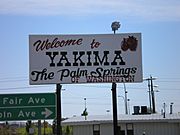
Roads and Highways
Interstate 82 is the main highway through the Yakima Valley. It connects Yakima to Ellensburg and the Tri-Cities. From there, you can connect to Seattle and Oregon. U.S. Route 12 and U.S. Route 97 also pass through Yakima.
Public Transportation
Yakima Transit is the city's public bus system. It serves Yakima, Selah, West Valley, and Terrace Heights. There are also free bus services to nearby towns like Union Gap and Toppenish.
Airport
The Yakima Air Terminal is a local airport. It is used for private planes and commercial flights. Alaska Airlines offers daily flights to and from Seattle-Tacoma International Airport. The airport is also a test site for military jets and Boeing test flights.
Notable People from Yakima
- Oleta Adams, singer
- Jamie Allen, baseball player
- Colleen Atwood, costume designer
- Mario Batali, chef
- MarJon Beauchamp, basketball player
- Wanda E. Brunstetter, author
- Bryan Caraway, mixed martial artist
- Raymond Carver, author and poet
- William Charbonneau, founder of Tree Top Apple Juice
- Beverly Cleary, author
- Harlond Clift, baseball player
- Cary Conklin, football player
- Alex Deccio, politician
- Garret Dillahunt, actor
- Dan Doornink, football player
- William O. Douglas, U.S. Supreme Court Justice
- Dave Edler, baseball player, former Yakima Mayor
- Mary Jo Estep, teacher
- Gabriel E. Gomez, politician
- Kathryn Gustafson, artist
- Gordon Haines, NASCAR driver
- Scott Hatteberg, baseball player
- Joe Hipp, boxer
- Al Hoptowit, football player
- Myke Horton, football player
- Damon Huard, football player
- Robert Ivers, actor
- Harry Jefferson, NASCAR driver
- Marshall Kent, bowler
- Sam Kinison, actor and comedian
- Larry Knechtel, musician
- Cooper Kupp, football player
- Craig Kupp, football player
- Jake Kupp, football player
- Mark Labberton, seminary president
- Donald A. Larson, World War II flying ace
- Robert Lucas Jr., economist
- Paige Mackenzie, golfer
- Kyle MacLachlan, actor
- Debbie Macomber, author
- Phil Mahre, Olympic skier
- Steve Mahre, Olympic skier
- Barbara La Marr, actress and writer
- Mitch Meluskey, baseball player
- Colleen Miller, actress
- Don Mosebar, football player
- James "Jimmy" Nolan Jr., TV host
- Arvo Ojala, actor and artist
- Joe Parsons, snowmobiler
- Floyd Paxton, inventor
- Gary Peacock, Jazz musician
- Steve Pelluer, football player
- Jim Pomeroy, motocross racer
- William Farrand Prosser, U.S. Congressman and mayor
- Gary Puckett, singer
- Pete Rademacher, boxer
- Monte Rawlins, actor
- Jim Rohn, entrepreneur
- Will Sampson, actor and artist
- Kurt Schulz, football player
- Mel Stottlemyre, baseball player and coach
- Mel Stottlemyre Jr., baseball player
- Todd Stottlemyre, baseball player
- Thelma Johnson Streat, artist
- Taylor Stubblefield, football player
- Miesha Tate, mixed martial artist
- Willie Turner, sprinter
- Janet Waldo, actress
- Bob Wells, baseball player
- Christopher Wiehl, actor
- Lis Wiehl, author and legal analyst
- Jon Westling, president of Boston University
- Chief Yowlachie, Native American actor
Sister Cities
Yakima has two sister cities:
See also
 In Spanish: Yakima (Washington) para niños
In Spanish: Yakima (Washington) para niños




